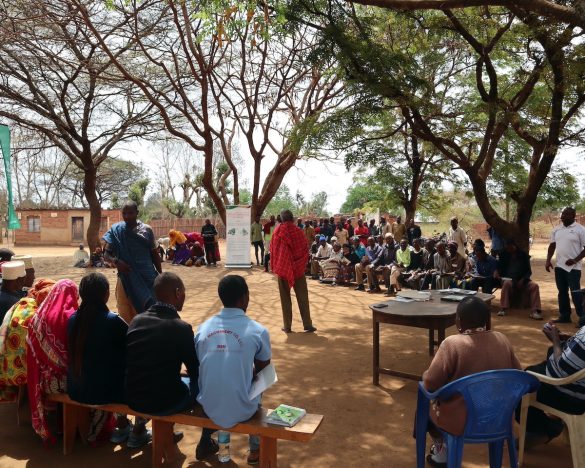RISING voices: Carlo Azzarri, Monitoring and Evaluation coordinator (IFPRI)
In this interview, Carlo Azzarri introduces himself and his work with Africa RISING. It is one of a series of portraits of key people in the program.
Tell us about your background
I am a research fellow at the International Food Policy Research Institute (IFPRI) in the Environment and Production Technology Division (EPTD). I joined IFPRI in September 2011 and have been in charge of the Monitoring and Evaluation (M&E) component of Africa RISING officially since December 2012, although IFPRI’s involvement in the program started even before the first inception workshops.

My background is in development economics with major in econometrics. I studied at the University of Rome. The reason why I was brought in Africa RISING is that I have some experience in leading M&E – especially impact evaluations of development projects – analyzing large micro-level datasets, and conducting large multi-topic household and community surveys in developing countries with the World Bank and the Food and Agriculture Organization (FAO).
What do you do in your current position?
We are trying to set up a monitoring system to report (on the nine chosen indicators) to the United States Agency for International Development (USAID). We are trying to build a user-friendly web interface, under development) so that the research teams and mega-site coordinators can monitor these indicators, overlay their values with a suite of biophysical and socio-economic characteristics at a fine spatial resolution level available at HarvestChoice, and upload any documentation relevant to the program.
Our second objective is to try and provide a consistent evaluation (using impact assessment as well as other methods) across the three mega sites. It’s a challenge because it’s one of the first agricultural research for development (AR4D) projects that tries to provide an economic evaluation.
I am coordinating the team and we are focusing our current activities on the household and community surveys in all Africa RISING countries, looking at a lot of quantitative indicators and outcome variables so as to provide a baseline values of all the relevant characteristics and targets.
It is fascinating to work with CGIAR colleagues from different centres with diverse backgrounds. It’s challenging sometimes but undoubtedly very enriching for my professional development to interact with the non-economists in the group.
What are your plans for Africa RISING?
The main goal is to provide guidance to our program coordinators about the performance of each intervention – which is very difficult – and to evaluate in a solid way the AR4D approach. It’s all new research for us because there is very little literature on this topic: a special issue in Food Policy in February 2014 focused on assessing AR4D interventions mostly through impact evaluation methods; it’s a very recent topic and we would like to be part of the recent literature on this. It’s one of my primary goals.
The other important goal is to convince the program donor for a second phase of the project, thanks to our statistically sound evaluation. If we do it carefully, we can show how the project has performed over the initial four-five years. We may end up with success or failure but the crucial aspect for us is to measure it rigorously. It is a learning phase for us all and we are trying to generate knowledge on the performance of the project with the ultimate objective to impact the livelihood of the poor.
What are the biggest Africa RISING challenges and how do we deal with them?
The two biggest challenges I see are interrelated:
- We have embarked on an AR4D program but USAID is a development, not a research institution. The donor has tasked many CGIAR centres to provide independent, decentralized, [participatory, demand-driven research interventions on the ground but has contracted IFPRI to provide a coherent and unified M&E framework. This leads to the other challenge…
- Our CGIAR colleagues are not economists (they are breeders, plant pathologists, agronomists, etc.) so we have different methods, views, and tools on how to evaluate performances, using also different metrics. The challenge is precisely to integrate the two approaches. Economists conducting evaluations are often too constrained by their background to look at the broader options for evaluation. On one hand, they should put more efforts in understanding agronomist practices, and the different delivery mechanisms through which the interventions spread spatially. On the other hand, agronomists should understand and approve the economic and statistical methods to go beyond input-output measures.
One important contribution of economist in that direction is that our actions are driven by (and founded on) statistical principles. We want to say something about the general validity of our conclusions regarding the effects of the treatment provided; that is the biggest challenge.
The contribution of agronomists is that they have a better understanding of how proper research adoption should proceed and how we should look at metrics related to bio-physical science. Taken together we can provide insights about the effects of technology adoption on one side, and on farm inputs/outputs and farmers’ wellbeing on the other.
Anything else you want to share?
I feel sorry about the fact that we built an extremely long and tedious household questionnaire (taking about four hours on average for farmers to complete). Every time we present it to the research teams, the reaction is that the questionnaire is overly long; nevertheless, every time they ask: “can you add this important module for us?”. Some of the questions are perhaps less relevant to them than what they would like to ask but we have to integrate the two approaches in one questionnaire. Trying not to confuse farmers. Hence, it’s quite a task to juggle around those needs. And, in addition, we do not always know which information our agronomist colleagues would like to solicit, so that’s why we try to be as comprehensive as possible, but at a quite substantial cost.





Latest Comments